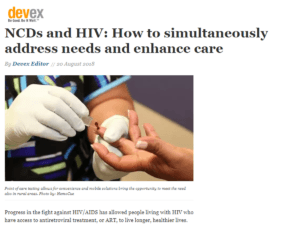 Noncommunicable diseases, chiefly cardiovascular diseases, cancers, respiratory diseases, and diabetes, are now responsible for 80 percent of “premature” deaths — occurring between the ages of 30-69 — in low- and middle-income countries. Due to the inflammatory effects of HIV, the side effects of ART, and the consequences of aging, people living with HIV appear to be at a higher risk of developing NCDs, especially considering that some HIV medicines can increase blood glucose levels and lead to diabetes.
Noncommunicable diseases, chiefly cardiovascular diseases, cancers, respiratory diseases, and diabetes, are now responsible for 80 percent of “premature” deaths — occurring between the ages of 30-69 — in low- and middle-income countries. Due to the inflammatory effects of HIV, the side effects of ART, and the consequences of aging, people living with HIV appear to be at a higher risk of developing NCDs, especially considering that some HIV medicines can increase blood glucose levels and lead to diabetes.
However, what could be seen as a challenge may also represent an opportunity to leverage the infrastructure and systems — for example, supply chains, training of health care practitioners, availability of diagnostics medicines, and more — that have successfully been set up in developing countries over the past decades to prevent, screen, and treat HIV, and to deliver high-impact interventions for other diseases at the primary health care level.
“The investment and hard work on the part of donors, ministries of health, health workers, and communities has helped to create a highly functional system with which to deliver chronic HIV care, and this has the potential to support chronic disease services more generally,” said Miriam Rabkin, director for health systems strategies at ICAP Columbia and associate professor of medicine and epidemiology at Columbia University’s Mailman School of Public Health, in an interview with Devex.






